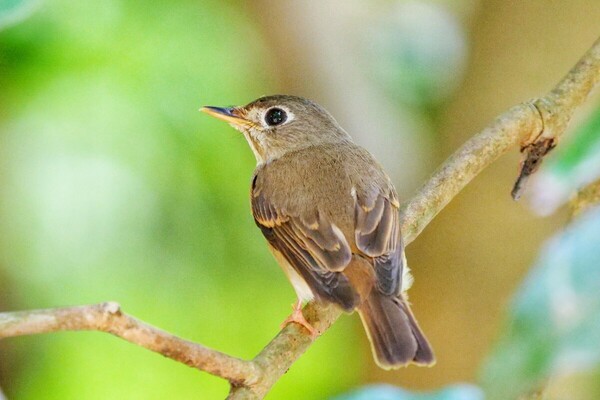Hemipus picatus
IUCN
LCBasic Information
Scientific classification
- name:Hemipus picatus
- Scientific Name:Hemipus picatus,Bar-winged Flycatcher-shrike
- Outline:Songbird
- Family:
Vital signs
- length:13-15cm
- Weight:
- lifetime:
Feature
Small bird, 13-15 cm long. The upper body and sides of the head are black with a blue metallic luster. The back is dark brown and the waist is white. The wings are dark brown, and the middle coverts, the innermost large coverts and the outer edges of the inner flight feathers are all white, forming a unique white spot on the wings. The tail is black with a white end spot. The lower body is white on the chin, under the cheeks and the sides of the neck, and the rest of the lower body is light grape brown.
Distribution and Habitat
Distributed from India, Sri Lanka, eastward along the Himalayas to Indochina, the Malay Peninsula, Indonesia, and southeastern Tibet in mainland China, western, southern and southeastern Yunnan, central and southern Guizhou, southwestern Guangxi, etc. It inhabits mountain broad-leaved forests, rain forests, and mixed coniferous and broad-leaved forests at an altitude of about 2,000 meters or less. It is also found in sparse forests at the edge of forests and sparse shrub grass slopes. Especially in the breeding season, it mostly inhabits dense mountain forests. In winter, it is mostly active in sparse woodlands in low mountains, hills, and plains at the foot of the mountains. Sometimes it also appears in roadside bushes and trees on the edge of farmland. In the non-breeding season, it often moves in groups in the middle and upper layers of the woodland.
Appearance
The upper body of the male bird is black with a blue metallic sheen from the forehead, top of the head, pillow, back neck and sides of the head. The back, shoulders and waist are brown or dark brown, and the lower back and waist feathers have wide white end spots, making the waist appear white. The upper tail coverts are black, and the tail is also black. The outer tail feathers have white end spots, and the white end spots become larger toward the outside. The dark brown middle coverts on both wings are white at the tip, and the inner large coverts and the outer edges of the inner flight feathers are also white, forming a unique white wing spot on the wings. The chin, lower part of the cheek, the sides of the neck and the front of the shoulders are white, forming half a ring. The rest of the lower body is half grape brown or smoky brown, and the feathers under the tail turn white.
The female bird is roughly similar to the male bird, but the forehead, head, pillow, and back neck are
Details

The brown-backed flycatcher mainly breeds in mountain forests at an altitude of 800-2100 meters, and the breeding season is from March to June. It builds nests on trees, usually at the outer end of horizontal branches in the canopy layer. The nest is made of twigs, grass leaves, grass stems and grass roots, and the outer layer also has spider silk, moss and lichens. The nest is shallow cup-shaped, with a relatively delicate and solid structure. The nest is 3-10 meters above the ground, and 2-3 eggs are laid in each nest. There are two colors of eggs, one is light green and white with black-brown spots, and the other type is pink and white with black-brown and reddish-brown spots. The size of the egg is 15-17 mm × 12.4-13.7 mm.
It mainly inhabits mountain secondary broad-leaved forests, rain forests, monsoon forests, evergreen broad-leaved forests and coniferous broad-leaved mixed forests below 2100 meters above sea level. It is also found in sparse forests and sparse shrub grass slopes at the edge of the forest, between trees on the roadside or dam area, and in rain forests. They like to live in groups, often mixed with other species, and move between trees. They carefully search for hidden or startled insects, and then pounce on them like a shrike. In the non-breeding season, they often move in groups in the middle and upper layers of the forest. Especially in the breeding season, they often live in dense mountain forests, and in winter they are mostly active in the sparse woodlands of low mountains, hills and plains at the foot of the mountain, and sometimes appear in roadside bushes and trees on the edge of farmland.

They are resident birds in China and do not migrate. Except for the breeding period, they often move in pairs, and in other seasons they often move in groups. They are mostly active in the canopy of trees, and sometimes they are active on small trees and shrubs. They forage among the branches and leaves of the canopy, mostly by flying, and occasionally foraging on the ground.
It mainly feeds on insects, and its food mainly includes beetles, stink bugs, bees, moths, dragonflies, flies, leafhoppers and other insects and insect larvae of Coleoptera, Hemiptera, Hymenoptera, Lepidoptera Odonata. This species has a wide distribution range and is not close to the critical value of vulnerable and endangered species survival (distribution area or fluctuation range is less than 20,000 square kilometers, habitat quality, population size, and fragmented distribution area). The population trend is stable, so it is evaluated as a species without survival crisis.







